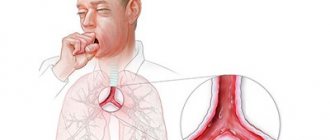Symptoms and treatment of bacterial bronchitis in children and adults.
The disease bacterial bronchitis is an inflammation that spreads to the mucous membrane located on the tracheobronchial tree.
This disease is quite rare in children.
However, timely diagnosis and treatment can protect the child from developing into a more complex form of the disease.
Bronchitis, provoked by a number of pathogenic bacteria, develops as a result of an advanced viral form. The disease can manifest itself for a number of reasons.
- Causes of bacterial bronchitis
- Types of bacterial bronchitis
- Symptoms of bacterial bronchitis
- How to distinguish bacterial bronchitis from viral bronchitis?
- Diagnosis of bacterial bronchitis
- Treatment of bacterial bronchitis
- Prevention of bacterial bronchitis
Causes of bacterial bronchitis
Like many viral diseases that affect the respiratory system, this type of bronchitis can begin to progress with hypothermia or upon contact with a carrier of the disease.
A feature of the bacterial form of bronchitis is infections of the bacterial flora.
These include:
- streptococci;
- staphylococci;
- pneumococci;
- and others.
Bacterial agents can enter the body of children through the lymphogenous or hematogenous route.
Children with weakened immune systems and those prone to allergies are at risk.
You also need to be careful about respiratory colds, since they are the initial cause of the development of the bacterial form of bronchitis.
Bacterial infections
There are significantly more bacterial infections caused by coughing and damage to the respiratory tract than viral ones. Among the most common are:
- Causative agents of whooping cough.
- Pneumococci.
- Chlamydia.
- Haemophilus influenzae.
- Streptococci.
It should be noted right away that in this case, there can be no talk of any antiviral drugs. Here it is necessary to use antibacterial therapy as soon as possible, as the consequences can be serious.
By the way, Staphylococcus aureus, which is so often sown and then treated with antibiotics, is not a dangerous pathogen. This agent enters the respiratory tract completely by accident; moreover, it is completely uncomfortable there even without drug therapy. It is used to living on the skin of any person and enters the body completely by accident.
Types of bacterial bronchitis
There are several types of bacterial bronchitis. Medical specialists distinguish between acute and chronic forms of the disease.
The acute form is an inflammatory process on the bronchial mucosa with the exception of damage to lung tissue.
Chronic bronchitis affects all layers of the bronchial wall.
There is another type of complications of the disease in children - chlamydial bronchitis.
This is an infectious form of the disease caused by parasites, chlamydia.
With proper treatment, it lasts for one week or two weeks.
Diagnostics
When listening, hard breathing, small or large bubble wheezing, which shifts and changes its character after coughing, is determined.
In a general blood test, the bacterial form is characterized by an increase in the level of leukocytes, band neutrophils, and an increase in ESR. Sputum examination includes bacterioscopy, culture on nutrient media to determine the type of bacteria and antibiotic resistance.
If bronchitis does not go away, an x-ray is indicated. The x-ray shows an increase in the vascular pattern of the lungs, but there are no shadows or infiltrates. In severe cases, when bacterial bronchitis does not respond to antibacterial treatment, the bronchi are washed and the water is tested for flora and sensitivity to antibiotics.
Symptoms of bacterial bronchitis
Bronchitis caused by a certain type of bacteria has certain symptoms.
From the very beginning, the disease has clearly defined symptoms.
The patient's main complaints include:
- lethargy;
- burning in the larynx;
- a sore throat;
- discomfort in the chest;
- cough;
- slight increase in body temperature;
- dyspnea.
As the disease develops, children develop symptoms of general weakness and malaise. The child is lethargic, loses his appetite, and refuses to play.
Pain in the chest area is explained by the presence of inflammation such as tracheitis.
The most pronounced symptoms in children and adults are sore throat and dry or wet cough.
A cough appears due to inflammation of the mucous membranes of the bronchi and trachea, which leads to irritation of the nerve endings.
Symptoms of bacterial bronchitis include the production of a small amount of sputum, which appears as a result of the development of inflammation of the mucous membranes.
While breathing, children may experience wheezing or harsh breathing.
During diagnosis, blood is taken for analysis, but the results most often do not show significant changes.
If treatment of the disease was not started at the first stage, then the symptoms begin to intensify.
Muscle pain appears, and the temperature rises and lasts for two to three days.
Symptoms such as cough and chest pain begin to progress, causing breathing problems, including shortness of breath. The amount of sputum also increases.
Even with proper treatment, bronchitis does not go away immediately. The main symptoms disappear after about a week.
The patient continues to be bothered by the following symptoms:
- cough;
- sputum.
But after three to four weeks the disease goes away completely.
Bacteria and throat diseases – World of Bacteria
Throat infections can occur independently in the presence of provoking factors. Their main danger lies in the fact that some bacteria cause complications in other systems and organs.
Throat infections
This is one of the most common problems. Not every immune system is able to withstand the attack of pathogenic viruses, bacteria, and fungi. The cause is most often reduced general or local immunity.
Infectious diseases can affect any part of the throat: the back wall, the tonsils, as well as the mucous membranes located nearby (the arch of the tonsils or the upper palate).
Once in the human body, viruses, bacteria, and fungi begin to actively multiply. This leads to the formation of an inflammatory process that has its own specific features. They are the main indicator for the doctor.
Causes
The appearance of pain or inflammation in the throat is not always associated with the development of infection. Therefore, the doctor must differentiate the disease from allergic reactions, excessive strain of the laryngeal muscles, and physical damage to the throat. In these cases, treatment with anti-inflammatory drugs will not bring results or will only help for a while.
In an infection, the causative agent is a specific microorganism. It can hit:
- by airborne droplets,
- through objects of infected people,
- with your own unwashed hands.
Sometimes the cause of the development of the disease is opportunistic microflora, which every person has. In this case, the prerequisite is an imbalance and weakening of the immune system.
The throat is an entry point for various types of infections. But before prescribing treatment, the doctor must determine the type of pathogen.
The photo shows the symptoms of a viral and bacterial throat infection
Bacterial
Bacteria exhibit increased activity when exposed to a warm and humid environment. They begin to destroy healthy cells, which leads to the formation of purulent processes. Symptoms may include:
Infection most often occurs through airborne droplets, through interaction with a sick person. Pathogens can lead to otitis media, sinusitis, lymphadenitis, sore throat, and retropharyngeal abscess.
Complications from bacterial pathology develop if the infection becomes generalized. Gradually, pathogenic microflora spreads throughout the body, which forms inflamed foci in all internal organs.
Streptococcus
This is a bacterium that lives on household items, on the skin, mucous membranes and in the digestive tract. It is not very resistant to high temperatures and the effects of disinfectants.
Streptococcus enters the throat through the air, poorly processed food, and through pets. It is impossible to completely exclude contact with him.
Streptococcus causes:
- scarlet fever,
- pharyngitis,
- tonsillitis.
In this case, the symptoms depend on the type of streptococcus and the affected area in the throat. Pharyngitis is characterized by a moderate increase in temperature, inflammation of the throat and palatine arches, and cough.
With angina, there is an enlargement of the tonsils, the formation of purulent foci and an increase in temperature to high levels. With scarlet fever, specific grains on the tongue and a typical rash on the body are added to the symptoms of sore throat.
Why streptococcal infection is dangerous, says Dr. Komarovsky:
Staphylococcus
This bacterium, like the previous species, is classified as opportunistic. The most dangerous is Staphylococcus aureus, which causes serious disease symptoms and complications. The bacterium is activated when the body’s immune forces decrease, during ARVI or influenza.
Staphylococcus leads to tonsillitis, pharyngitis, laryngitis. With purulent sore throat, the plaque is easily removed, but affects the tongue and arches. There are symptoms of general intoxication. These include headache and weakness. The sore throat is so severe that the person refuses to eat or eat.
With pharyngitis, there is an accumulation of viscous mucous deposits on the back wall, but not on the tonsils. Itching provokes attacks of dry cough. A sore throat appears. With laryngitis, the mucous membranes of the larynx are involved in the inflammatory process, involving the tracheal area. The latter provokes a strong dry cough, which eventually changes to a wet one.
Diphtheria bacillus
Diphtheria is an acute infectious disease caused by a special type of bacteria. But it is not the bacterium itself that poses the danger, but the toxin. It can affect the nervous system, heart, kidneys, and lead to death.
Infection occurs from a patient or a bacteria carrier. The sticks enter by airborne droplets, with drops of saliva or mucus. The entrance gate is the mucous membrane of the nasopharynx, wounds, and conjunctiva of the eye.
The diphtheria bacillus leads to swelling and necrosis of the mucous membrane, but the pain is less pronounced than with sore throat. Fever occurs when the toxin reaches the hypothalamus in the blood. The temperature lasts up to 14 days. The doctor may note a slight enlargement of the tonsils. One of the features of the disease is the absence of a runny nose.
Whooping cough stick
Whooping cough is caused by the bacterium Bordetella pertussis. It can be infected by airborne droplets. The disease occurs with the phenomenon of convulsive paroxysmal cough and damage to the respiratory and cardiac systems. Often, whooping cough causes a spasm in the throat, but the area of the larynx and nasopharynx is less susceptible to the disease.
During development, the rod releases toxins into the mucous membrane, which affect the nervous system. The poisoning process leads to disruption of sleep and eating patterns.
Koch stick
It causes tuberculosis of the larynx. In most cases, the disease develops against the background of pulmonary tuberculosis and spreads to the larynx. Symptoms include hoarseness of voice and difficulty swallowing. Thickening of the tissue occurs, which causes stenosis and lack of oxygen. Treatment consists of taking medications.
Most often, Koch's bacilli cause a chronic infiltrative form. In the initial stages it occurs without symptoms. Gradually there is an increase in temperature, the appearance of a dry cough, and a feeling of fullness.
Other bacteria, such as gonococcus or pneumococcus, can also cause a sore throat. Gonococcus leads to the appearance of a white-yellow plaque. The lymph nodes become enlarged, salivation increases, and bad breath appears. Painful sensations when swallowing and at rest. Symptoms of stomatitis also appear.
Pneumococcus is a spherical bacterium. In the throat, infection rarely develops, since the ears and respiratory system are most affected. The disease affects the nervous system, heart and gastrointestinal tract.
Viral
Infections caused by the introduction of infectious agents into the body. Viruses can be 100 times smaller than bacteria and fungi. The peculiarity is that within 3-7 days immunity forms cells in relation to such an infectious agent. Therefore, illnesses usually last no more than a week.
Etiology of acute viral infections
Influenza viruses
This species mainly affects the respiratory tract. More than 2000 different types of such viruses have been identified. The source of infection is a sick person with an obvious or latent form of the disease. It is contagious for about a week.
Without testing, it is impossible to distinguish influenza from other types of acute respiratory viral infections. Therefore, in practice, the diagnosis is established only on the basis of epidemiological data. Typical picture:
The throat is slightly red, there is slight swelling of the mucous membrane.
Rhinoviruses
They mean acute viral infection of the nose and nasopharynx. The temperature does not rise above 38 degrees. A sore throat, sneezing, and runny nose appear. The sense of smell disappears. Rhinovirus leads to rhinitis and pharyngitis. Cells of the picornavirus family become agents for infection.
Intoxication syndrome is weakly expressed. Due to the appearance of secretions from the nose in large quantities, peeling of the skin around the nose appears. When a bacterial infection is attached, the development of laryngitis, viral sore throat and some other diseases is possible.
How is a viral infection transmitted:
Adenoviruses
Adenovirus infection affects the respiratory tract, eyes, and lymphoid tissue. Depending on the characteristics of the immune system, there may be a different course of the disease. An early symptom is an increase in body temperature to 39 degrees and mild symptoms of intoxication.
Discharge from the nose and swelling of the back of the throat appear. It is possible to form pinpoint plaque on the tonsils. When the disease occurs in the intestinal form, the following occurs:
- mesenteric lymphadenitis,
- fever,
- diarrhea,
- vomit.
Other types
Enterovirus infection occurs as an acute respiratory viral infection, accompanied by fever and catarrhal inflammation of the respiratory tract. It is caused by ECHO types 11 and 20, the Coxsackie virus. Basically, the disease begins acutely, sometimes with chills and headache. The source is patients and virus carriers. Infection occurs through the fecal-oral and airborne routes.
Coronavirus infection leads to the development of respiratory and intestinal diseases. The first reproduction occurs in the nasopharynx mucosa. In adults, a runny nose is typical, and in children, bronchitis and pneumonia develop.
Herpes
Herpes in the throat rarely appears. Most often, blisters form on the mucous membrane of the mouth, but they can affect any area of the body. If a rash appears in the throat, the doctor may indicate a severe form of the disease. Usually the causative agent is the herpes simplex virus.
It is often mistaken for sore throat, stomatitis, and bacterial diseases. The temperature always rises, the head and other areas in the mouth turn red. You can see the appearance of bubbles with liquid inside.
How to identify herpetic sore throat, watch our video:
Fungal
Fungal infection leads to laryngitis and tonsillitis. Sometimes a person does not realize that he has a problem. The most common mycosis is Candidiasis. During swallowing, the pain intensifies and hyperemia of the mucous membrane appears. A distinctive feature from other diseases is a white discharge similar to cottage cheese.
A yellow coating may appear on the tongue and back wall. This indicates the development of mold fungi. Swelling of the nasopharynx and tonsils is almost always observed, and body temperature rises. When the palatine, pharyngeal and lingual tonsils are involved in the infectious process, fungal tonsillitis develops.
In addition to candidiasis, aspergillosis, blastomycosis and some others may appear in the throat.
Diagnostic methods
If you experience a sore throat, you should consult a doctor immediately, as the cause of this symptom may be dangerous. The examination includes:
- Collecting anamnesis during a conversation.
- Analysis of the general condition of the applicant.
- Examination of the throat.
- Palpation of the neck in the area of the throat and lymph nodes.
During cultural sowing, the pathogen is grown for a certain period of time. Sometimes an enzyme-linked immunosorbent assay is used to determine antigens and antibodies in the material being studied.
How to determine a viral or bacterial infection based on test results, watch our video:
Features of treatment of infections of different etiologies
Treatment can be general and specific. In the first case, drugs are used:
- antipyretics,
- anti-inflammatory,
- painkillers.
If the disease is caused by a bacteria, the doctor will most likely prescribe antibiotics. Antihistamines are often prescribed to reduce swelling and cramping. To treat a viral illness, antiviral drugs and agents to enhance the immune response are prescribed. When fungus develops, antiseptics with an antifungal effect are prescribed.
The patient, regardless of the type of disease, must drink a lot. Additionally, rinsing is prescribed using a solution of soda and salt and chamomile. Today in pharmacies there are also special lozenges. They relieve pain from the throat and have a local antiseptic effect.
Prognosis and methods of prevention
The prognosis for timely treatment is almost always favorable. In most cases, the course of the disease depends on how strong a person’s immunity is. For prevention you can:
- temper,
- Healthy food,
- live in an apartment with sufficiently humidified air.
If there has been contact with a sick person, then rinsing can be used as a preventative measure. It is also carried out in the off-season. Decoctions of sage, calendula, eucalyptus, and pine buds are used as antiseptics.
Doctors recommend changing your toothbrush after every illness. When sick, viruses, bacteria and fungi remain on it even with good care. Some of them can remain alive in such conditions for a long time. After an infection and during illness, drink rosehip decoction with honey.
Source: https://dmnesterov.ru/sistematika/bakterii-i-zabolevaniya-gorla.html
Bronchitis is bacterial or viral: how to determine?
Viruses, unlike bacteria, develop much more slowly.
In most cases, a bacterial disease is superimposed on an existing viral one.
The main difference between viral infections of the respiratory system is the absence of purulent discharge (sputum).
Bacteria are able to die and decompose, which causes a purulent process.
The type of disease can be determined using a blood test.
Diagnosis of bacterial bronchitis
Before you begin treatment for bronchitis, you should conduct a thorough diagnosis in a medical facility.
When there are complaints about the health of children, the doctor first conducts an examination and asks about what symptoms are tormenting the patient.
Based on the diagnostic results, a preliminary diagnosis is made.
Additional diagnostic methods
In order to obtain a more accurate clinical picture, it is necessary to undergo a number of additional studies.
Additional methods include:
- general blood test;
- X-ray;
- sputum analysis for microflora.
To exclude the development of tuberculosis, the patient undergoes a bacteriological examination procedure.
Also, in case of bacterial inflammation of the bronchi in children, spirography is performed (study of the state of external respiratory functions).
Sometimes your doctor may prescribe a bronchoscopy. But such examinations are carried out very rarely in children.
Treatment of bacterial bronchitis
For bacterial bronchitis in children, treatment should begin after the first signs of the disease appear.
Treatment involves eliminating the infection that triggered the development of the disease.
To do this, the patient is prescribed a number of antibiotics, the use of which must comply with the doctor’s recommendations.
To reduce the symptoms of bronchitis, it is necessary to treat with cough suppressants and analgesics.
And just as with any respiratory disease, treatment of the child should be accompanied by rest and plenty of fluids.
For more complex forms of the disease, treatment involves taking antispasmodic and countercurrent drugs that relieve bronchospasms.
Treating bacterial bronchitis at home
Treatment at home also speeds up the healing process.
The safest way to alleviate the patient's condition is to warm the calf muscles with mustard plasters. Also useful are herbal decoctions that help relieve inflammation and irritation of the respiratory system.
If you have a dry cough or fever, you should avoid applying compresses and rubbing.
Before using traditional medicine methods, you should consult your doctor.
Productive and non-productive cough
A productive cough is accompanied by the production of mucus or sputum. Mucus from the respiratory tract can sometimes even end up in the nose and sinuses. A productive cough should not usually be suppressed; it helps clear mucus from the lungs. There are many reasons why a productive cough occurs, including:
- Viral infections. A productive cough is a common symptom of a cold. It is caused by the formation of excess mucus in the lungs and airways.
- Bacterial infections. Bacterial infections of the lungs or upper respiratory tract can cause a cough. This cough may be a symptom of pneumonia, bronchitis, sinusitis or tuberculosis.
- Chronic lung disease. A productive cough may be a sign of worsening chronic obstructive pulmonary disease (COPD), chronic bronchitis, and pneumonia.
- Entry of gastric juice into the esophagus. This type of cough may be a symptom of gastroesophageal reflux disease (GERD), during which acidic stomach juices enter the esophagus and irritate its walls.
- Smoking. A cough from a smoker indicates irritation of the throat or esophagus, as well as damage to the lungs.
A nonproductive cough is dry and not accompanied by sputum production. A dry cough may develop at the end of a cold or after exposure to an irritant such as dust or smoke. There are many reasons why this cough occurs:
- Viral infections . After a cold, a dry cough can last several weeks longer than other symptoms and often gets worse at night.
- Bronchospasm . In this disorder, a nonproductive cough occurs at night and is a sign of spasms in the bronchi (bronchospasm) caused by irritation.
- Allergy . Coughing and frequent sneezing are common symptoms of allergic rhinitis.
- Medicines such as angiotensin-converting enzyme inhibitors, which are used to control high blood pressure, can cause a dry cough.
- Exposure to foreign substances : dust, fumes and chemicals in the working environment.
- Asthma . A chronic dry cough may be a sign of bronchial asthma. Other symptoms may include difficulty breathing, shortness of breath, or a tightness in the chest.
- Blockage of the airway by a foreign object, such as food or a pill.











